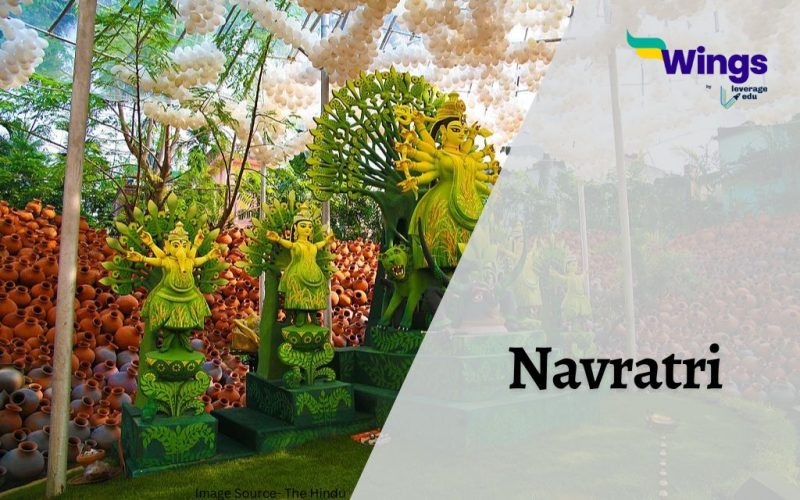Navratri, a vibrant and auspicious Hindu festival celebrated with great fervor, holds a significant place in the hearts of millions of people in India and among Hindu communities worldwide. The name “Navratri” is a combination of two words: “Nav,” meaning nine, and “Ratri,” meaning nights. This festival spans nine nights and ten days, during which devotees immerse themselves in worship, prayer, fasting, and vibrant cultural celebrations. Navratri is not just a religious observance; it is a kaleidoscope of cultural diversity, devotion, and celebration. In this extensive exploration, we will delve into the multifaceted dimensions of Navratri, encompassing its religious significance, cultural expressions, regional variations, and the unifying spirit that this festival embodies.
Must Read: Essay On Navratri In Hindi
Religious Significance
Navratri is a celebration of the divine feminine energy, and its primary focus is on honoring Goddess Durga. She is the embodiment of strength, power, and courage, symbolizing the divine force that protects and nurtures the universe. The festival commemorates the legendary victory of Goddess Durga over the demon Mahishasura, signifying the triumph of good over evil. Navratri is not just a festival of prayer but a profound expression of faith and devotion towards this powerful deity.
Nine Forms of Durga
The festival spans nine nights, and each night is dedicated to one of the nine forms or incarnations of Goddess Durga. These forms represent different facets of her divine power, and devotees worship each form with deep reverence. The nine forms include Shailaputri, Brahmacharini, Chandraghanta, Kushmanda, Skandamata, Katyayani, Kalaratri, Mahagauri, and Siddhidatri. These forms are a source of inspiration for devotees who seek blessings, strength, and protection in their lives.
Devotion and Prayer
Navratri is a time of intensified devotion and prayer. Devotees visit temples, perform elaborate rituals, and engage in devotional singing to express their reverence for Goddess Durga. Special pujas (prayer ceremonies) are conducted, where priests offer prayers and seek blessings on behalf of the community. Many devotees fast during this period as a mark of their dedication and spiritual commitment. Fasting is often rigorous, involving abstaining from certain foods, and some individuals even observe complete fasting without any solid intake.
The Celebration: Dance, Music, and Colors
Navratri is not just a religious event; it’s a spectacular display of culture, dance, music, and vibrant expressions of joy. The cultural facets of Navratri are celebrated in various forms, and the most prominent ones are Garba and Dandiya Raas.
- Garba: In the state of Gujarat, Garba is the quintessential dance of Navratri. It involves men and women dancing in concentric circles, moving rhythmically and gracefully to traditional folk songs. The circular motion symbolizes the cycle of life and the cosmic dance of the divine. The dance is characterized by intricate footwork and graceful hand movements, making it a visual and rhythmic delight.
- Dandiya Raas: Dandiya Raas is another popular dance form during Navratri, often performed in pairs. Participants hold sticks (dandiyas) and engage in a rhythmic dance, striking their sticks in harmony with the music. Dandiya Raas is particularly popular in Gujarat and other parts of India with large Gujarati communities.
- Colorful Attire: During Navratri, participants dress in vibrant and traditional attire. Women wear chaniya cholis (traditional skirts and blouses), often adorned with intricate embroidery and mirror work. Men opt for kurtas (traditional tunics) and dhotis (traditional pants). These colorful and ornate outfits add to the festive atmosphere and symbolize the cultural richness of the festival.
Must Read: All About Dussehra
Fasting and Prayer: A Spiritual Journey
Navratri is not just a time for dance and celebration; it is also a spiritual journey for many devotees. Fasting is a significant aspect of this journey, and it is observed with great dedication and discipline.
- Types of Fasting: Devotees follow various types of fasting during Navratri. Some may abstain from consuming any form of grains, while others may restrict themselves to fruits and dairy products. There are also those who undertake a complete fast, refraining from any solid food throughout the nine days. The choice of fasting method often depends on individual preferences and beliefs.
- Spiritual Cleansing: Fasting during Navratri is seen as a means of cleansing the body and mind. It is believed to purify the soul and help devotees focus on their spiritual journey. Many consider it an opportunity to break free from unhealthy eating habits and reflect on their relationship with food.
- Prayer and Meditation: Alongside fasting, devotees engage in prayer, meditation, and reading of sacred texts. These activities are aimed at deepening their connection with Goddess Durga and seeking her blessings. The quiet introspection during fasting and prayer is an essential part of the Navratri experience.
Community Gatherings
Navratri brings people together, fostering a sense of community and unity. The festivities are not confined to homes and temples; they extend to public spaces and community centers.
- Temples: Temples across India are adorned with flowers and lights during Navratri. Special pujas and aartis (rituals involving the waving of lamps) are conducted, attracting devotees from near and far. These congregations create a strong sense of togetherness and shared spirituality.
- Cultural Associations: Cultural organizations and clubs play a significant role in organizing Navratri events. These events typically feature live music, dance performances, and cultural programs. They are open to the entire community, and people from various backgrounds come together to celebrate in a spirit of joy and inclusivity.
- Social Harmony: The communal aspect of Navratri promotes social harmony and unity. People of all ages, backgrounds, and social strata join in the celebrations, breaking down barriers and fostering a sense of oneness. Navratri acts as a bridge that connects people across differences, strengthening the bonds of community.
If you want to read more facts like this, you can check out our general knowledge page.
 One app for all your study abroad needs
One app for all your study abroad needs













